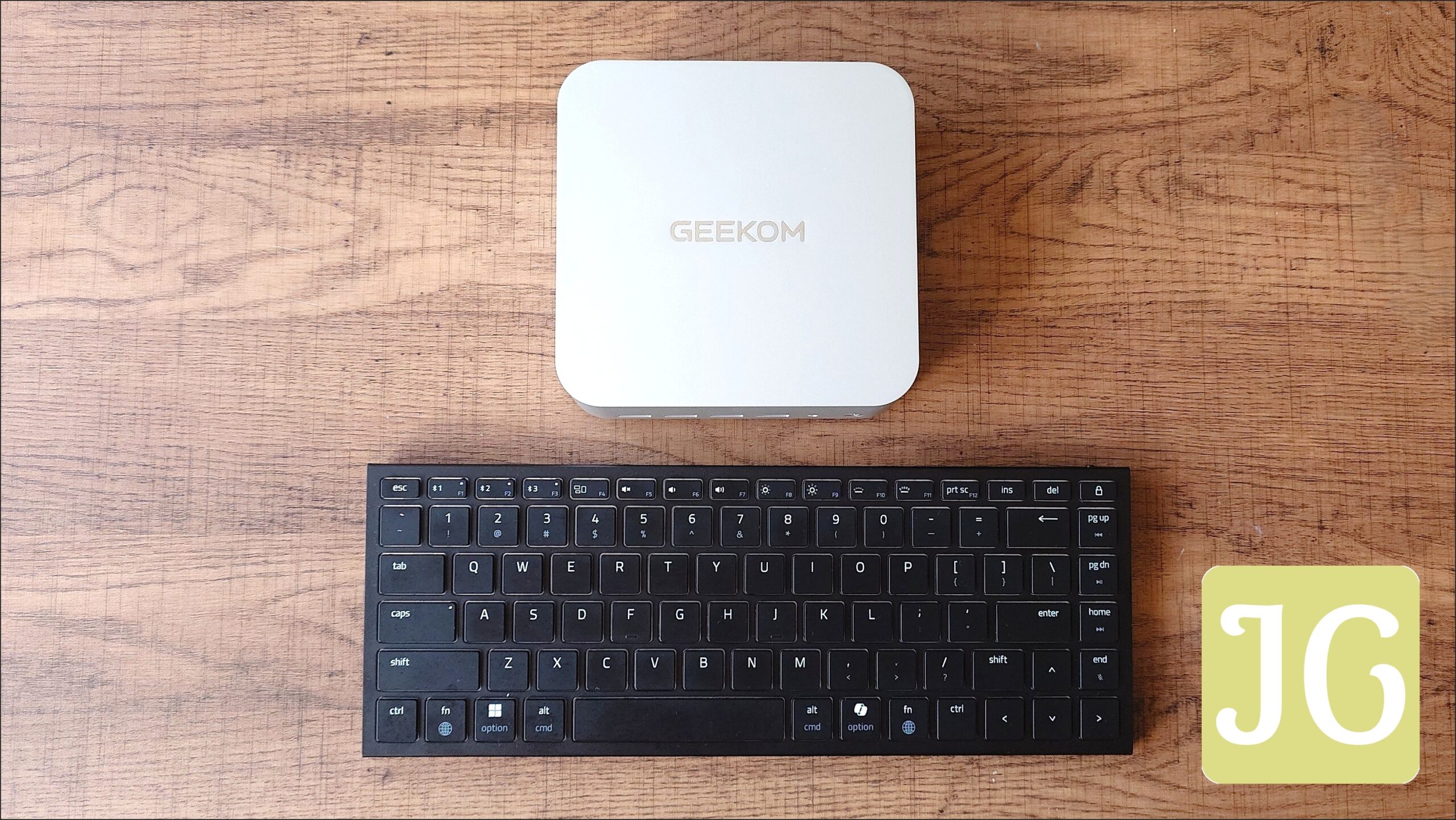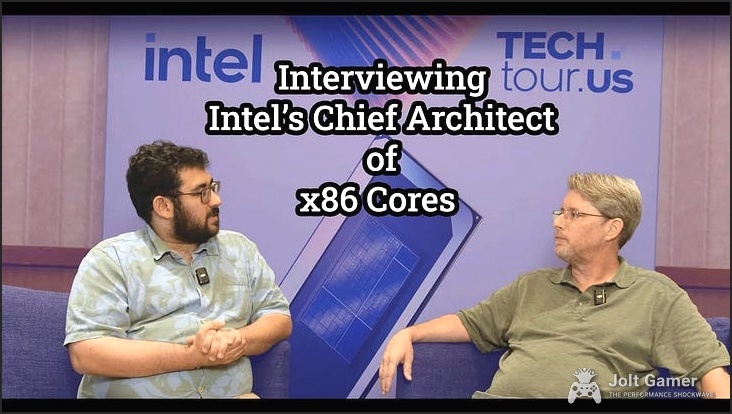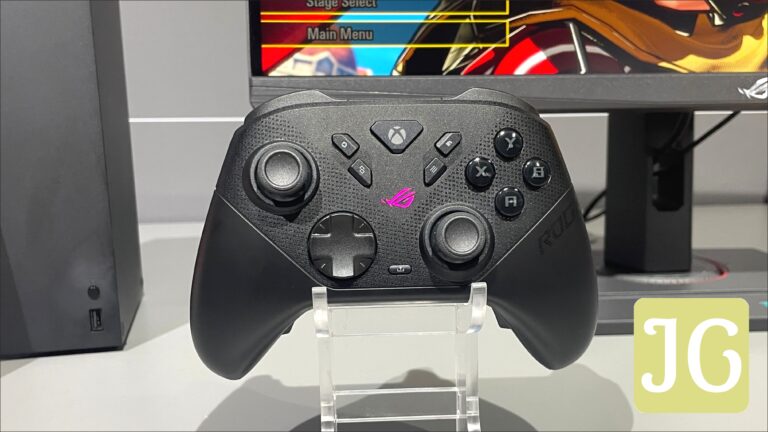Key Takeaways
- The GEEKOM A9 Max, powered by AMD’s Ryzen AI 9 HX370, sets a new standard for mini PC performance with 80 TOPS of AI acceleration and strong 1080p gaming via its Radeon 890M iGPU.
- It boasts robust connectivity (USB4, Wi-Fi 7, dual 2.5G Ethernet), extensive expandability (up to 128GB DDR5 RAM, 8TB SSD storage), and military-grade durability in a compact, VESA-mountable chassis.
- While AMD touts significant gaming leads over Intel, independent testing suggests a more nuanced picture, with frame generation heavily influencing AMD’s benchmark claims.
- The community is impressed by its raw power and size but remains skeptical about its current price-to-performance for gaming/AI, concerned about thermals, and curious about practical AI use cases.
- Priced at $999 (with 32GB RAM/2TB SSD), it offers a compelling, energy-efficient solution for gamers, creators, and hybrid professionals, backed by a 3-year warranty and 24/7 support.
Introduction: The Dawn of a New Mini PC Era?
The world of compact computing is constantly evolving, and at the forefront of this revolution is GEEKOM with its new flagship, the A9 Max Mini PC. Launched to significant fanfare, this diminutive powerhouse aims to redefine expectations for what a small form factor system can achieve, especially for gamers, content creators, and professionals leveraging AI. Powered by AMD’s cutting-edge Ryzen AI 9 HX370 processor, the A9 Max promises a blend of raw processing power, advanced integrated graphics, and groundbreaking AI capabilities, all packed into a chassis that fits in the palm of your hand. But does it truly deliver on its ambitious claims, and how does it stack up against a rapidly advancing competitive landscape? We dive deep into every facet of this intriguing new contender.

GEEKOM A9 Max Mini PC
Price: $999 (Launch price: $1,199)
Release Date: August 21, 2025
Where to Buy:
- GEEKOM Official Website
- Amazon Store
Configuration Notes: Includes 32GB DDR5 RAM and 2TB PCIe Gen4 SSD at this price.
At a Glance: GEEKOM A9 Max Core Specifications
GEEKOM A9 Max Mini PC Technical Specifications
- Processor
- AMD Ryzen AI 9 HX370 (12 Cores/24 Threads, 4 Zen 5 + 8 Zen 5c, Max. Boost 5.1 GHz, 24MB L3 Cache, 15-54W TDP)
- Graphics
- AMD Radeon 890M (16 CUs, RDNA 3.5 Architecture, up to 2,900 MHz)
- AI Performance
- 80 TOPS total AI acceleration (50 TOPS NPU via XDNA 2 engine)
- RAM
- 32GB DDR5 SO-DIMM (Dual-channel, expandable up to 128GB)
- Storage
- 2TB PCIe Gen4 SSD (Dual M.2 slots: 1x 2280, 1x 2230, up to 8TB total)
- Operating System
- Windows 11 Pro (pre-installed), Linux/Ubuntu compatible
- Connectivity
- Wi-Fi 7, Bluetooth 5.4, Dual 2.5G RJ45 LAN
- Ports
- 2x USB4 Type-C (40Gbps, DP 1.4, PD), 5x USB 3.2 Gen 2 Type-A (10Gbps), 1x USB 2.0 Type-A, 2x HDMI 2.1 (4K@120Hz), 1x SD Card Reader, 1x 3.5mm Headphone Jack, 1x Kensington Lock
- Display Support
- Up to 4 displays simultaneously (up to 8K)
- Cooling System
- IceBlast 2.0 (Copper heatsink, dual heat pipes, quiet high-performance fan)
- Chassis
- Reinforced full-metal shell, VESA Mount Compatible
- Dimensions
- 135 mm × 132 mm × 46.9 mm
- Power Supply
- 120W external adapter
- Warranty
- 3-Year Limited Warranty, 24/7 Online Assistance
The Brains: AMD Ryzen AI 9 HX370 Processor Deep Dive
At the heart of the GEEKOM A9 Max lies the AMD Ryzen AI 9 HX370 processor, a formidable chip built on AMD’s latest 4nm TSMC FinFET ‘Strix Point’ architecture. This processor leverages the innovative Zen 5 microarchitecture, promising a significant 15% IPC improvement over its predecessor, Zen 4. What makes the HX370 particularly interesting is its hybrid core configuration, featuring 12 Cores and 24 Threads. This includes four powerful Zen 5 cores (with a Max. Boost Clock of 5.1 GHz) and eight more energy-efficient Zen 5c cores (boosting up to 3.3 GHz). This design allows for exceptional processing performance across demanding tasks, multitasking, and modern productivity, with a configurable TDP ranging from 15W to 54W to balance performance and efficiency. For the A9 Max, GEEKOM has configured it at a robust 54W, ensuring optimal power delivery for intensive workloads.
Ryzen AI 9 HX370 Key CPU Features:
- Architecture: AMD ‘Strix Point’ (4nm TSMC FinFET) with Zen 5 cores
- Core/Thread Count: 12 Cores / 24 Threads (4x Zen 5, 8x Zen 5c)
- Max. Boost Clock: 5.1 GHz
- L3 Cache: 24MB
- TDP: Configurable from 15W to 54W (A9 Max set to 54W)
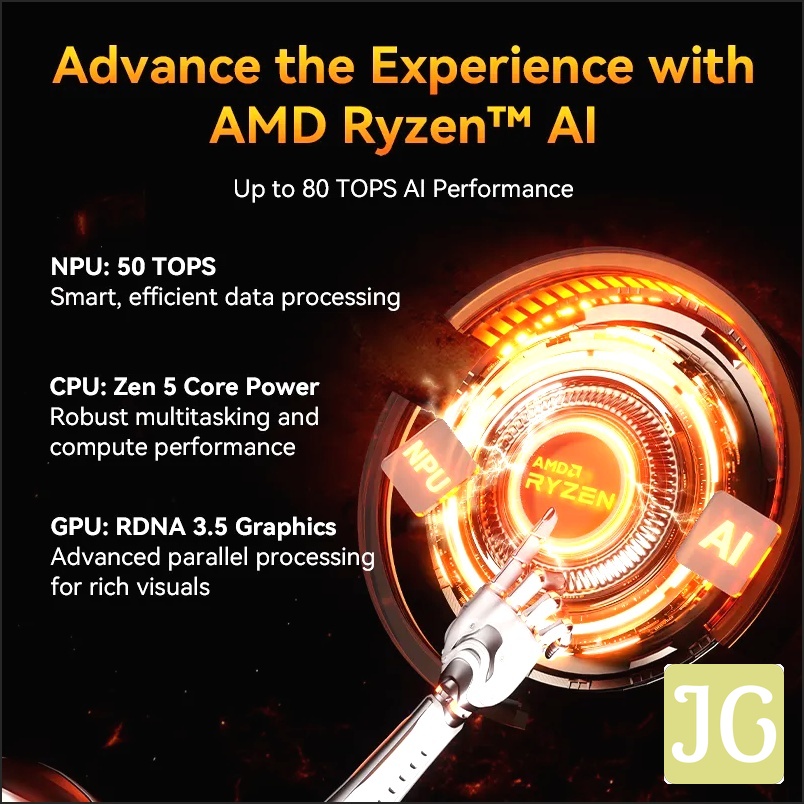
AI Unleashed: Ryzen AI Engine & XDNA 2 NPU
The ‘AI’ in Ryzen AI 9 HX370 isn’t just marketing; it signifies a dedicated XDNA 2 engine-powered Neural Processing Unit (NPU) that delivers up to 50 TOPS of AI performance. Combined with the CPU and GPU, the A9 Max achieves a staggering 80 TOPS of total AI acceleration. This makes it a certified Microsoft Copilot+ PC, enabling critical real-time AI workloads directly on the device, reducing reliance on cloud services. We’re talking intelligent noise cancellation, advanced facial recognition, accelerated content creation (like Stable Diffusion and Topaz AI), and the ability to run local large language models (LLMs) via tools like LM Studio and Ollama with impressive efficiency. For developers and creators, this means a significant leap in on-device AI processing power, opening doors for advanced content generation and supporting AMD’s Ryzen AI roadmap.
What are TOPS and Why Do They Matter?
TOPS (Trillions of Operations Per Second) is a key metric for measuring the performance of AI accelerators like NPUs. Higher TOPS generally indicate greater capability for complex AI tasks, enabling faster processing for features like intelligent noise cancellation, image upscaling, and running local AI models. For a Copilot+ PC, a minimum of 40 TOPS is required, which the GEEKOM A9 Max comfortably exceeds with its 80 TOPS total AI acceleration.
Graphics Powerhouse: Radeon 890M iGPU
Complementing the powerful CPU and NPU is AMD’s most potent integrated GPU to date: the Radeon 890M. Built on the RDNA 3.5 architecture with 16 Compute Units (CUs), this iGPU is designed to deliver stunning graphics performance that rivals entry-level discrete GPUs. It promises smooth 1080p gaming across a wide range of titles and even supports hardware-accelerated ray tracing, a feature once exclusive to high-end discrete cards. With FSR (FidelityFX Super Resolution) support, the A9 Max can further boost frame rates in supported games, ensuring a responsive and visually engaging experience. This translates directly to more fluid gameplay and enhanced visual fidelity for gamers who prioritize a compact setup.
GEEKOM A9 Max (Radeon 890M) 1080p Gaming Performance (GEEKOM Claims)
Performance figures based on GEEKOM’s official marketing materials. Actual performance may vary.
Performance Unpacked: Benchmarks & Real-World Gaming
While GEEKOM and AMD paint a picture of dominant gaming performance, especially when compared to Intel’s integrated solutions, a closer look at independent testing reveals a more complex reality. AMD’s marketing materials often highlight an average 75% performance lead for the Ryzen AI 9 HX370 with Radeon 890M over Intel’s Core Ultra 7 258V. However, these figures are heavily influenced by AMD’s benchmark methodology, which extensively leverages software performance boosters, a practice that warrants closer scrutiny for a fair comparison.
GEEKOM A9 Max (Radeon 890M) Gaming Performance: Claims vs. Reality
| Game Title | AMD Claimed FPS (1080p, FSR/AFMF Enabled) | Independent Testing FPS (1080p, Native Settings) |
|---|---|---|
| Cyberpunk 2077 | 110 FPS | 61 FPS (medium, FSR balanced, without frame gen) |
| Call of Duty: Black Ops 6 | 99 FPS | 77 FPS (balanced, FSR balanced, without frame gen) |
| Black Myth: Wukong | 85 FPS | 50+ FPS (Intel Lunar Lake comparison, AMD likely similar native) |
| Far Cry 6 | N/A | 50+ FPS |
| Forza Horizon 5 | N/A | 66 FPS (high) |
| Shadow of the Tomb Raider | N/A | 61 FPS (medium, XeSS balanced, without frame gen) |
AMD’s claims often include FSR 3 with Fluid Motion Frames or AFMF 2. Independent testing (e.g., Tom’s Hardware, Windows Central) focuses on native performance or less aggressive upscaling/frame generation to ensure fair comparison.
The industry largely views the inclusion of frame generation in benchmarks, especially for direct product comparisons, as a ‘dishonest’ practice… while upscaling provides genuine performance gains at the expense of image quality, frame generation, which creates ‘fake frames,’ fundamentally obfuscates critical metrics such as input latency, which is considered as vital as visual frame rate.
AMD’s strategy heavily relies on software enhancements like FSR 3 (with Fluid Motion Frames), AFMF 2 (driver-based frame generation), and HYPR-RX (combining Anti-Lag, RSR, Radeon Boost, and AFMF2) to achieve its impressive frame rates. While these technologies undeniably boost performance, particularly on AMD’s own platforms, critics argue that their inclusion in direct comparisons against competitors (like Intel’s XeSS, which lacks frame generation) creates an uneven playing field. Independent testing by outlets like Tom’s Hardware, which deliberately avoids these ‘performance enhancing’ settings for a more ‘native’ comparison, found Intel’s Arc 140V iGPU actually held a slight lead over the Radeon 890M at both 720p and 1080p, a stark contrast to AMD’s advertised 75% lead. This doesn’t diminish the A9 Max’s capability to deliver solid 1080p gaming at 60 FPS or higher on medium to high settings, especially when leveraging FSR, but it’s crucial for consumers to understand the context behind benchmark numbers and how frame generation impacts the perceived smoothness versus raw rendering power and input latency.
Design & Engineering: Compact Power, Robust Build
GEEKOM A9 Max Design Highlights

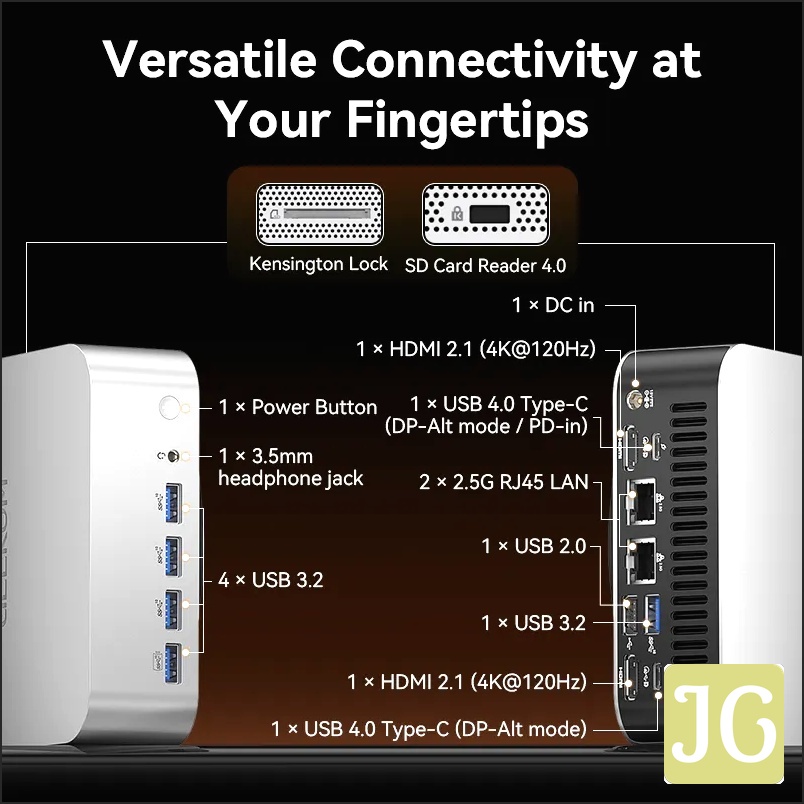
The GEEKOM A9 Max isn’t just about internal power; its external design and build quality are equally impressive. Housed in a sleek, premium metallic chassis, the unit is designed for exceptional resilience, capable of withstanding up to 200 kg of pressure without bending. Its compact dimensions (135 mm × 132 mm × 46.9 mm) make it comparable in size to the latest Mac Mini, allowing for versatile deployment. It’s VESA Mount Compatible, enabling secure attachment behind monitors or beneath desks for a clutter-free setup. GEEKOM’s commitment to durability is further evidenced by 339 comprehensive tests, including 90 minutes of vibration testing and 120 hours of extreme temperature testing (operating flawlessly from -20°C to 55°C), ensuring long-lasting reliability even in challenging environments.
IceBlast 2.0 Cooling System
Despite its compact size and powerful 54W TDP processor, the A9 Max features the innovative IceBlast 2.0 cooling system. This system incorporates a dedicated copper plate CPU heatsink, oversized twin copper heat pipes, a large copper heatsink, and a quiet high-performance fan. Coupled with an efficient side intake/rear exhaust airflow, it delivers 52% more efficient thermal performance than standard systems, crucial for maintaining stability during heavy workloads and intense gaming sessions.
Connectivity & Expandability: Future-Proofing Your Setup
Comprehensive Connectivity Options:
- Wireless: Wi-Fi 7, Bluetooth 5.4
- Wired Network: Dual 2.5G RJ45 LAN ports
- High-Speed Data/Display: 2x USB4 Type-C (40Gbps, DP 1.4, Power Delivery)
- USB Peripherals: 5x USB 3.2 Gen 2 Type-A (10Gbps, one ‘Always On’), 1x USB 2.0 Type-A
- Display Output: 2x HDMI 2.1 (4K@120Hz), supporting up to four 8K displays simultaneously
- Media: Integrated SD Card Reader
- Audio: 3.5mm Headphone Jack
Beyond its impressive port selection, the GEEKOM A9 Max offers excellent internal expandability, a significant advantage over many compact systems. It supports dual-channel DDR5 SODIMM memory, allowing users to upgrade up to a massive 128GB RAM. For storage, it features dual ultra-fast NVMe SSD slots (one M.2 2280 PCIe 4.0 and an additional M.2 2230 PCIe 4.0), each supporting up to 4TB SSDs, totaling 8TB of potential storage. This level of upgradability ensures the A9 Max can adapt to evolving needs, extending its lifespan and value by allowing users to scale memory and storage as their demands grow, rather than being locked into initial configurations.
Connectivity & Expandability: Pros and Cons
Pros
- Cutting-Edge Wireless: Wi-Fi 7 and Bluetooth 5.4 for future-proof networking.
- High-Speed USB4: Dual ports offer 40Gbps, power delivery, and 8K display output.
- Dual 2.5GbE LAN: Excellent for network-intensive tasks and server applications.
- Extensive USB-A: Plenty of ports for peripherals, including an ‘Always On’ option.
- Impressive RAM Expandability: Up to 128GB DDR5 via SODIMM slots.
- Dual NVMe SSD Slots: Supports up to 8TB total PCIe 4.0 storage.
Cons
- No Oculink Port: Limits compatibility with Oculink-specific external GPUs, though USB4 eGPU support is present.
The Community Perspective: Fandom Pulse Check
The launch of the GEEKOM A9 Max, particularly with its powerful AMD Ryzen AI 9 HX370, has certainly stirred the waters within the PC gaming and tech enthusiast communities. There’s a palpable sense of excitement regarding the raw power packed into such a compact form factor. However, this excitement is tempered by a healthy dose of skepticism and practical concerns, reflecting a community that demands both innovation and value.
「この辺りのグレードの製品は性能の割にかなりの省スペースなものの、ゲーミングやAIだと性能や拡張性で物足りず、軽い用途にはちょっと値段が高く、合う人には合うかもしれませんが、下位モデルでコストを下げたり、出揃ってない395等に期待している人が多い印象です。」 (Translated: “Products in this tier, despite being space-saving for their performance, often fall short in performance or expandability for gaming and AI. For lighter uses, the price is a bit high. While it might suit some, many are hoping for lower-cost entry models or anticipating the not-yet-released 395 and similar chips.”)
A dominant emotional hotspot is a blend of Skepticism and Hope. Users are impressed by the sheer power and compact size but question the current price-to-performance ratio for serious gaming and AI applications. This sentiment often stems from the fact that while the A9 Max is incredibly capable for its size, dedicated gaming desktops or more specialized AI workstations might offer a better raw performance-per-dollar. There’s a clear desire for future, more mature generations of these mini PCs, particularly those that might offer better value or even more advanced chips like the rumored ‘395’, indicating a forward-looking but cautious market.
「ミニPC見てるとここまで小さくなくていいので、もうちょっとヒートシンクを大きくしてファンも静かなものをと思ってしまう。。」 (Translated: “Looking at mini PCs, I don’t need them to be this small, so I wish they’d make the heatsink a bit bigger and the fan quieter…”)
This leads to a strong undercurrent of Concern regarding potential thermal limitations and fan noise. While the A9 Max features the IceBlast 2.0 cooling system, designed for efficiency, the community’s historical experience with powerful components in small form factors often leads to a desire for slightly larger designs that could prioritize even better cooling and acoustics over absolute miniaturization. The pursuit of extreme compactness, while impressive, sometimes comes with perceived trade-offs in sustained performance and quiet operation, especially under peak load.
「ヤヴァいミニpcの使い道とは………」 (Translated: “What exactly is the use case for such an insane mini PC………”)
Finally, there’s significant Curiosity about the practical and compelling use cases for these powerful AI-enabled mini PCs. Beyond raw benchmarks, users are intrigued but uncertain about how to best leverage the advanced AI capabilities and integrated graphics in their daily workflows or gaming habits. This suggests a need for clearer articulation of real-world benefits and innovative applications, as the cutting-edge technology outpaces immediate understanding of its everyday utility.
GEEKOM A9 Max vs. The Competition
The mini PC market is more competitive than ever, with offerings from Intel, Apple, and various other brands. The GEEKOM A9 Max, with its AMD Ryzen AI 9 HX370, enters this arena as a formidable contender. Let’s see how it stacks up against some notable rivals, offering a clearer picture of its position in the rapidly evolving landscape.
GEEKOM A9 Max vs. Key Rivals
| Feature | GEEKOM A9 Max | Intel NUC 13 Pro (i7-1370P) | Apple Mac Mini (M4) |
|---|---|---|---|
| Processor | AMD Ryzen AI 9 HX370 (Zen 5, 12C/24T) | Intel Core i7-1370P (Raptor Lake, 14C/20T) | Apple M4 (10C CPU) |
| Integrated GPU | Radeon 890M (RDNA 3.5, 16 CUs) | Intel Iris Xe Graphics | Apple M4 (10C GPU) |
| AI Performance (TOPS) | 80 TOPS | ~15-20 TOPS (CPU/GPU only) | ~38 TOPS (NPU) |
| RAM (Max) | 128GB DDR5 (SODIMM) | 64GB DDR5 (SODIMM) | 24GB (Unified Memory, non-upgradable) |
| Storage (Max) | 8TB (2x PCIe 4.0 M.2) | 4TB (1x M.2, 1x 2.5″ SATA) | 2TB (Integrated, non-upgradable) |
| Connectivity | Wi-Fi 7, BT 5.4, Dual 2.5GbE, 2x USB4 | Wi-Fi 6E, BT 5.2, 1x 2.5GbE, 2x Thunderbolt 4 | Wi-Fi 6E, BT 5.3, 1x 1GbE, 2x Thunderbolt 4 |
| Price (Base Config) | $999 (32GB/2TB) | ~$700-$1000 (Barebones/Configured) | ~$1299 (8GB/256GB) |
Specifications and pricing are approximate and can vary by configuration and market. The Mac Mini’s unified memory and storage are not user-upgradable.
Who Is the GEEKOM A9 Max For?
The GEEKOM A9 Max is a versatile machine, but its unique blend of features makes it particularly appealing to specific user groups:
Ideal Users for the GEEKOM A9 Max:
- 1080p Gamers: With its Radeon 890M iGPU, the A9 Max offers solid 1080p gaming performance, often exceeding 60 FPS on medium-to-high settings in many popular titles, especially when paired with FSR. This makes it an excellent choice for those who want a compact, capable gaming machine without the footprint or cost of a traditional desktop, providing a strong balance of performance and space-saving design.
- Content Creators & Developers: The AMD Ryzen AI 9 HX370’s 80 TOPS of AI acceleration and powerful CPU cores make it ideal for demanding tasks like video editing, 3D rendering, and local AI model deployment (e.g., Stable Diffusion, LLMs via LM Studio). Its robust connectivity, multi-display support, and ability to run AI workloads on-device significantly enhance productivity and creative workflows.
- Hybrid & Remote Professionals: The compact, VESA-mountable design, extensive connectivity (Wi-Fi 7, dual 2.5G Ethernet), and enterprise-grade security features (Windows 11 Pro, TPM 2.0) make it a perfect fit for modern flexible work environments. It offers desktop-class performance in a portable package, potentially saving on energy costs compared to traditional desktops while maintaining high productivity.
- Tech Enthusiasts & Hobbyists: Those who appreciate cutting-edge technology, want to experiment with local AI, or simply desire a powerful, future-proof mini PC with excellent upgradability will find the A9 Max highly appealing. Its advanced features and robust architecture provide a strong platform for innovation and exploration.
Is it a Copilot+ PC? Yes, but with nuances.
The GEEKOM A9 Max, thanks to its 80 TOPS of AI performance from the Ryzen AI 9 HX370, technically qualifies as a Microsoft Copilot+ PC. This means it’s capable of running advanced AI features directly on the device. However, it’s worth noting that at launch, some specific Copilot+ features, like the ‘Recall’ function, may not be available on all AMD platforms, or might be rolled out in phases. Its primary strength lies in its raw AI compute power for various local AI applications beyond just Copilot+.
Final Verdict: A Powerful Contender with Room to Grow
The GEEKOM A9 Max Mini PC is a compelling entry into the high-performance compact computing market. Powered by the AMD Ryzen AI 9 HX370, it delivers impressive CPU and AI performance, coupled with a surprisingly capable Radeon 890M iGPU for 1080p gaming. Its robust build, extensive connectivity, and excellent upgradability make it a versatile solution for a wide range of users, from gamers and content creators to hybrid professionals. While AMD’s aggressive performance claims should be viewed with context (especially regarding frame generation in benchmarks), the A9 Max undeniably offers solid real-world performance, consistently achieving playable frame rates in 1080p gaming. Community concerns about current price-to-performance for specific use cases and thermal management are valid, highlighting areas for future iteration. However, at its $999 price point (with 32GB RAM/2TB SSD), backed by a strong 3-year warranty and 24/7 support, the A9 Max presents a strong value proposition as a compact, energy-efficient, and highly capable machine for those seeking cutting-edge AI and integrated graphics in a small form factor.
GEEKOM A9 Max Scorecard
Overall Score: 4.5 / 5.0
Frequently Asked Questions About the GEEKOM A9 Max
What is the AMD Ryzen AI 9 HX370 processor?
It’s AMD’s flagship mobile processor, built on the 4nm Zen 5 architecture with 12 cores/24 threads and an integrated Radeon 890M GPU, featuring a dedicated XDNA 2 NPU for 80 TOPS of AI performance. It’s designed for high performance, gaming, and advanced AI workloads in compact devices.
Can the GEEKOM A9 Max run AAA games?
Yes, it can run many AAA games at 1080p resolution with medium to high settings, often achieving 60 FPS or higher, especially with AMD’s FSR technology enabled. It’s a capable 1080p gaming machine for its size.
Is the GEEKOM A9 Max upgradable?
Yes, it offers excellent upgradability. It supports up to 128GB of dual-channel DDR5 SO-DIMM RAM and features two PCIe 4.0 M.2 SSD slots, allowing for up to 8TB of total storage.
What are the main advantages of a mini PC like the A9 Max?
Key advantages include its compact size (space-saving), portability, lower power consumption compared to traditional desktops, and often quieter operation. The A9 Max specifically offers high performance for its form factor, advanced AI capabilities, and robust connectivity.
Does it support external GPUs (eGPUs)?
Yes, the GEEKOM A9 Max supports eGPUs via its dual USB4 ports, allowing users to connect external graphics cards for even higher gaming or compute performance. However, it lacks an Oculink port for Oculink-specific eGPUs.
Sources & References
- GEEKOM Official Press Releases & Website (August 21, 2025)
- PR Newswire via Morningstar.com (August 21, 2025)
- Digital Engineering (GEEKOM A9 Max announcement)
- Windows Central Review by Richard Devine (Sample provided by GEEKOM, independent editorial)
- Tom’s Hardware (Independent testing on AMD vs. Intel iGPU performance)
- Guru3D (AMD Ryzen AI 9 HX 370 processor analysis)
- UL Benchmarks (3DMark CPU Profile for AMD Ryzen AI 9 HX 370)
- PassMark Software (CPU Mark & Thread Rating for AMD Ryzen AI 9 HX 370)
- Wccftech.com (Intel Core Ultra 7 268V ‘Lunar Lake’ CPU review by ThinkView)
- McKinsey & Company (Hybrid work statistics)
- OfficeRnD (Hybrid work report 2024)
- Harvard Business Review (Remote work productivity)
- Gallup (Hybrid worker engagement)
- AMD Blog Post (Ryzen AI 9 HX 370 performance claims)

